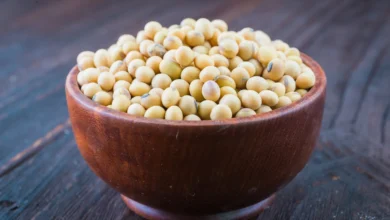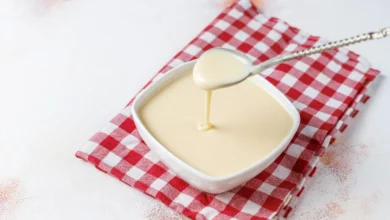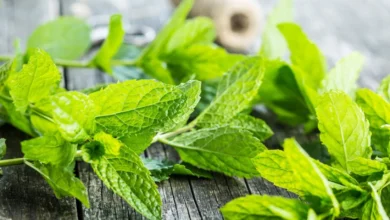How to Make Delicious Whipped Honey in Minutes (Easy Recipe)

Have you ever encountered a jar of crystallized honey in the back of your pantry? While that thick, sticky texture might seem difficult to work with, you’re in for a treat! With a bit of effort and understanding, you can transform crystallized honey into something exceptional: whipped honey.
Contents
- How to Make Whipped Honey
- Whipped Honey vs. Creamed Honey: Any Difference?
- The Magical Process of Whipping
- Why Whip Your Honey?
- Whipped Honey Recipe and Guide
- What is the Best Honey for Whipping?
- Making Whipped Honey Without Seed Honey
- Does Whipped Honey Taste Different?
- How to Use Whipped Honey
- Whipped Honey Flavors: Delicious Whipped Honey Variations
- Health Benefits of Whipped Honey
- When is Honey Better Used Un-Whipped?
- How to Store Whipped Honey
- Frequently Asked Questions
- Can I use regular honey?
- How long does it take to whip honey?
- What if I don’t have a stand mixer?
- Can this creamed honey be frozen?
- Can this recipe be doubled?
- How do you make homemade creamed honey?
- What is the best way to store creamed honey?
- What is the difference between creamed honey and honey?
- How do you make crystallized honey?
How to Make Whipped Honey
Ready to learn how to make whipped honey? Let’s do it!
Whipped Honey vs. Creamed Honey: Any Difference?
You might have noticed the terms “whipped honey” and “creamed honey” used interchangeably. Technically, they refer to the same product – honey that’s been processed to have a smooth, spreadable texture. The difference is in terminology, not the delicious honey itself!
The Magical Process of Whipping
Whipping crystallized honey is the key to creating creamy, airy, and spreadable magic. Imagine this process as breaking down those gritty crystals into a smooth and uniform texture, making it easier to spread on your favorite toast, biscuits, or maybe even waffles.
Here’s where a touch of my personal experience comes in: The best part is, you won’t even notice the sweetness level has changed because all you are doing is introducing air. This allows the delicate flavor of the pure honey to shine through, making whipped honey a truly luxurious experience.
Why Whip Your Honey?
- Enhanced Spreadability: Forget struggling with thick, sticky honey. Whipped honey spreads effortlessly on breads, crepes, pancakes, and other delicious foods.
- Lighter Texture: Ditch the heaviness – whipped honey boasts a light and airy texture that melts in your mouth.
- Versatility: The creamy consistency makes whipped honey ideal as a condiment or a delightful addition to various other recipes.
The Power of Whipping
The process of whipping crystallized honey actually breaks up the larger crystals, resulting in a smoother texture. While you won’t completely get rid of all the crystals, especially if your honey had larger ones to begin with, the difference will be noticeable. The degree of smoothness also depends on the type of honey used.
Bonus of Whipped Honey
Interestingly, storing whipped honey can give it a longer shelf life compared to liquid honey. This is because whipped honey tends to slow the natural process of crystallization.
Whipped Honey Recipe and Guide
Let’s turn that crystallized honey into a delightful treat!
What You’ll Need
- Crystallized honey: This is the star of the show. The amount is flexible, ensuring you have a good supply.
- Mixer: A stand mixer or hand mixer is ideal for whipping lots of air into the honey.
- Patience: The magical transformation takes time.
The Whipping Process
- Start with Your Base: Transfer your crystallized honey into the mixer bowl.
- Warm It Up (if necessary): If your honey isn’t already in a fresh, semi-liquid state, you’ll need to warm it slightly. The easiest way is with a double boiler or a heatproof bowl placed over a pot of simmering water. Let it warm until it becomes liquid again, but avoid overheating to protect the natural enzymes and flavor.
- Whip It Good: Start on low speed and gradually increase to medium-high. Let the mixer work its magic, whipping and stretching the honey. Remember, patience is your secret ingredient!
- Watch and Wait: Whipping can take around 20–30 minutes. You’ll see the color gradually lighten and the texture become fluffier.
Tips
- Don’t have crystallized honey? You can gently warm liquid honey and slowly add a small amount of crystallized honey to kickstart the crystallization process.
- Customize it! Try adding a touch of vanilla extract or a sprinkle of cinnamon for a unique flavor experience.
Whipping By Hand
While mixers are convenient, you can make whipped honey by hand. Here’s how:
- Start with Crystallized Honey: Ensure you use crystallized honey.
- Whisk It: Use a sturdy whisk or fork and whip vigorously. The process will be slower and require more effort than a mixer.
- Be Patient: Continue whisking and periodically scrape the sides of the bowl. It may take 20–30 minutes or longer to achieve a light, fluffy texture.
Important Note: Whipping by hand might not produce the same ultra-smooth texture as a mixer, but you’ll still get a delightfully spreadable whipped honey.
What is the Best Honey for Whipping?
Not all honeys are created equal when it comes to whipping. The secret lies in the type of honey you choose! For the ideal creamy, spreadable whipped honey, look for varieties that naturally crystallize slowly. This process results in the formation of small crystals, the key to a smooth and luxurious texture.
Lighter-colored honeys, such as clover honey or orange blossom honey, typically fit the bill. These often have a lower water content, which is beneficial for achieving that airy whipped consistency. While you can whip darker honeys, they tend to crystallize quickly, forming larger, harder crystals.
If you only have solidified honey, fear not! You can easily transform it. To restore its pourable state, simply warm up the honey to soften and liquefy it. A gentle water bath or placing the jar in a warm place for several hours will help to dissolve the crystals. Just be careful not to overheat your honey, as this can destroy those precious natural enzymes and nutrients.
Making Whipped Honey Without Seed Honey
While using a small amount of already-crystallized honey (“seed honey”) is a common way to start the whipping process, it’s possible to create whipped honey without it. Here’s how:
- Start with High-Quality Honey: Choose honey that naturally crystallizes slowly, like clover or orange blossom honey. These varieties tend to produce smaller, finer crystals, ideal for whipped honey.
- Initiate Crystallization: If your honey is liquid, gently warm a small portion until it just begins to crystallize. Combine this with the rest of your liquid honey and mix thoroughly.
- Storage is Key: Place the honey mixture in a cool place, ideally your refrigerator. The cooler temperatures will accelerate the crystallization process.
- Whip and Repeat: Once your honey has significantly crystallized, you can proceed with normal whipping as described in the Whipped Honey Recipe section. It might require periodic re-crystallization during the whipping process if you notice it becoming too liquid.
Important Note: Making whipped honey without seed honey may require more time and effort. The texture might not be perfectly smooth, but you’ll still achieve a delicious, spreadable consistency.
Does Whipped Honey Taste Different?
Since whipping honey introduces air into the mixture, you might wonder if this process changes its texture, mouthfeel, and ultimately, the flavor. The result is a light, creamy consistency that feels smoother and more luxurious.
So, does it taste different? Many people find the flavor of whipped honey to be slightly more delicate compared to traditional liquid honey. This is likely because the whipping process helps break down some natural sugars, subtly affecting the sweetness profile. However, the core honey flavor isn’t drastically changed, especially if you haven’t added any extra flavorings like vanilla extract or cinnamon.
At the end of the day, the most significant difference lies in the texture, and how the honey interacts with the quality and variety of your food pairings. Of course, additional ingredients play a major role in the final flavor. If you’re curious, the best way to find out is to whip up a batch yourself with your favorite honey and see if you can tell the difference. Whipped or not, there’s nothing quite like the taste of pure, delicious honey!
How to Use Whipped Honey
Whipped honey opens up a whole new world of delicious possibilities! Here’s how to enjoy its versatility:
- The Ultimate Spread: Naturally, whipped honey is a fantastic spread for toast, biscuits, bagels, and more. It’s a lighter and flavorful alternative to traditional butter or jam. Experiment with flavored whipped honey – hints of cinnamon or vanilla extract would be delightful!
- Pancake and Waffle Wonder: Elevate your breakfast game by topping pancakes or waffles with whipped honey. It can be drizzled over for a touch of sweet, flavorful deliciousness.
- A Sweet Baking Boost: Because of its light, fluffy texture, whipped honey works beautifully as a natural sweetener in baking recipes. Incorporate it into cake batters, muffins, or other baked goods for a subtle sweetness.
- Glazes and Marinades: Move over, syrups! Whipped honey can be used to create flavorful, sweet glazes or marinades for meats like ham or chicken. Mix it with mustard, soy sauce, and other spices to bring a unique touch to your favorite recipes.
- A Lighter Touch: If you find traditional syrups cloying or overly rich, whipped honey is a fantastic alternative. It has a lighter, less dense sweetness compared to regular honey. Because of its whipped, creamy consistency, remember to use it sparingly as it melts wonderfully, drizzling down the top and sides of your favorite morning stack.
- Flavor Upgrades: Think beyond plain whipped honey – get creative! Combine it with a bit of softened butter for a decadent whipped honey butter. The recipe possibilities are endless, and there are so many fun versions to try!
Whipped Honey Flavors: Delicious Whipped Honey Variations
While plain whipped honey is delicious in its own right, the possibilities are endless when it comes to flavor combinations! Here are some popular ideas to tantalize your taste buds:
- Fruity Delights: Blueberry, raspberry, strawberry, or a touch of orange zest.
- Spice It Up: Cinnamon, a hint of ginger, or even a dash of jalapeño for the adventurous.
- Classic Comforts: Vanilla extract or a swirl of butter rum for a rich twist.
Important Note: It’s best to add your chosen flavors during the whipping process to ensure they fully incorporate into the honey.
Health Benefits of Whipped Honey
Whipped honey offers essentially the same health benefits as traditional liquid honey. Here’s why it’s a wonderful natural sweetener:
- Natural Sweetener: Whipped honey is pure honey, making it a more natural alternative to refined sugars.
- Antioxidants: Honey contains antioxidants, which may provide protection for your cells against damage.
- Potential Prebiotic: Honey contains certain types of sugar that might act as prebiotics, promoting the growth of beneficial bacteria in your gut.
- Soothing Properties: Some people find honey useful for its naturally soothing properties, potentially helpful for relieving a sore throat.
Important Note: It’s crucial to remember that honey is still a form of sugar. Moderation is key, especially if you have concerns about blood sugar management.
When is Honey Better Used Un-Whipped?
While whipped honey has its charms, there are times when un-whipped honey truly shines:
- When a Liquid Sweetener is Ideal: If you’re looking for a liquid sweetener, such as for drizzling over yogurt, tea, or cocktails, un-whipped honey is the way to go. You might also prefer using honeycomb in its natural state if you enjoy the unique texture it provides.
- Tried and True: Natural honey has long been used in recipes and as a traditional cold and cough remedy. If you have old, crystallized honey, there’s no need to whip it – just warm it slowly and stir until it reverts to its liquid form.
- Baking Substitutions: While whipped honey can sometimes replace liquid sweeteners in baked goods recipes, it’s not always a perfect substitute. You’ll likely need to adjust the recipe to achieve the desired results, especially since the whipped variety may change the overall flavor, texture, and sweetness level. Always consider your end goal and proceed with caution if substituting ingredients.
How to Store Whipped Honey
Unlike some other spreads, whipped honey has a long shelf life and can happily sit at room temperature without spoiling. However, if you live in a warmer climate, it might soften and lose its whipped consistency. To maintain that thick, spreadable texture, consider storing it in your refrigerator.
It’s normal for a bit of separation to happen over time. You might see a thin foamy layer at the top of the jar. Don’t worry, this doesn’t mean the honey’s gone bad! Simply stir the foam back into the honey or enjoy it as a little sweet treat on its own.
Storage Tips
Once whipped, transfer your honey to a clean jar with a tight-fitting lid. You can keep it at room temperature for weeks. If you notice it starting to set, or prefer it chilled for long-term storage, pop it in the fridge. It will solidify eventually, but can easily be re-whipped by warming slightly and giving it another mix for that creamy, smooth texture.
How Long Does Whipped Honey Last?
Whipped honey has a good shelf life and will last several weeks at room temperature when stored in an airtight container. Refrigeration can extend its shelf life. While it will eventually crystallize and solidify, it won’t become a runny mess like regular honey might, thanks to the whipping process. You can easily re-whip it by warming it slightly and giving it another mix.
RELATED: Homemade Pear Allspice Chutney
RELATED: Small Batch Banana Muffins
Conclusion
Whipped honey transforms a pantry staple into a delightful and versatile treat. Whether you find yourself with a jar of crystallized honey or simply crave a lighter, more spreadable sweetness, the whipping process is simple and rewarding. Remember, the type of honey you choose influences the final texture, and its incredible shelf stability lets you enjoy whipped honey for weeks. With endless flavor possibilities and a touch of natural sweetness, whipped honey is a delicious addition to your breakfasts, baked goods, and beyond! Whisk and Nibble hopes this guide helps you create some whipped honey magic in your own kitchen.
_____________________________
Frequently Asked Questions
Can I use regular honey?
Yes! While raw honey is best for whipping, regular processed honey works great. Raw honey is simply unfiltered and unpasteurized, while processed honey is often strained and jarred for long-term shelf stability.
How long does it take to whip honey?
The whipping time can vary depending on the type of honey, the equipment you’re using, and the desired consistency. Generally, expect to whip for around 20–30 minutes with a stand or hand mixer. You’ll know it’s ready when the honey becomes lighter and develops a thick, fluffy texture.
What if I don’t have a stand mixer?
A handheld mixer can absolutely be used, just be prepared for a bit of an arm workout! It might take longer than with a stand mixer and require occasional breaks.
Can this creamed honey be frozen?
While you can freeze honey, it’s not recommended. Honey is naturally shelf-stable and lasts for a long time, so there’s no need to freeze it. If you must freeze it, expect some changes in texture once thawed.
Can this recipe be doubled?
Absolutely! If you want a larger batch, simply double the recipe. For the best results, consider storing the whipped honey in separate smaller jars. This limits the amount of airflow every time you open a container. Large containers tend to be used up slower, giving the whipped honey more time to crystallize over time.
How do you make homemade creamed honey?
To make creamed honey at home, you’ll need a mixer with a whip attachment. Simply whip crystallized honey on medium speed for about 60 minutes until it turns into a creamy, white mixture. Store in an airtight container at room temperature.
What is the best way to store creamed honey?
An airtight container at room temperature is ideal. Choose a cool, dark place (like a pantry or cabinet) away from heat sources like your oven.
What is the difference between creamed honey and honey?
Creamed honey is processed to control crystallization, resulting in tiny crystals that prevent the formation of larger, grittier crystals. This gives it a smooth, spreadable consistency compared to the liquid form of unprocessed honey.
How do you make crystallized honey?
If you don’t have crystallized honey on hand, you can initiate the process by adding a tablespoon or two of already-crystallized honey to liquid honey and mixing well. This provides “seeds” for faster crystallization. Storing the mixture in your refrigerator, where temperatures are around 50 degrees Fahrenheit (10 degrees Celsius), will make it crystallize much faster.




